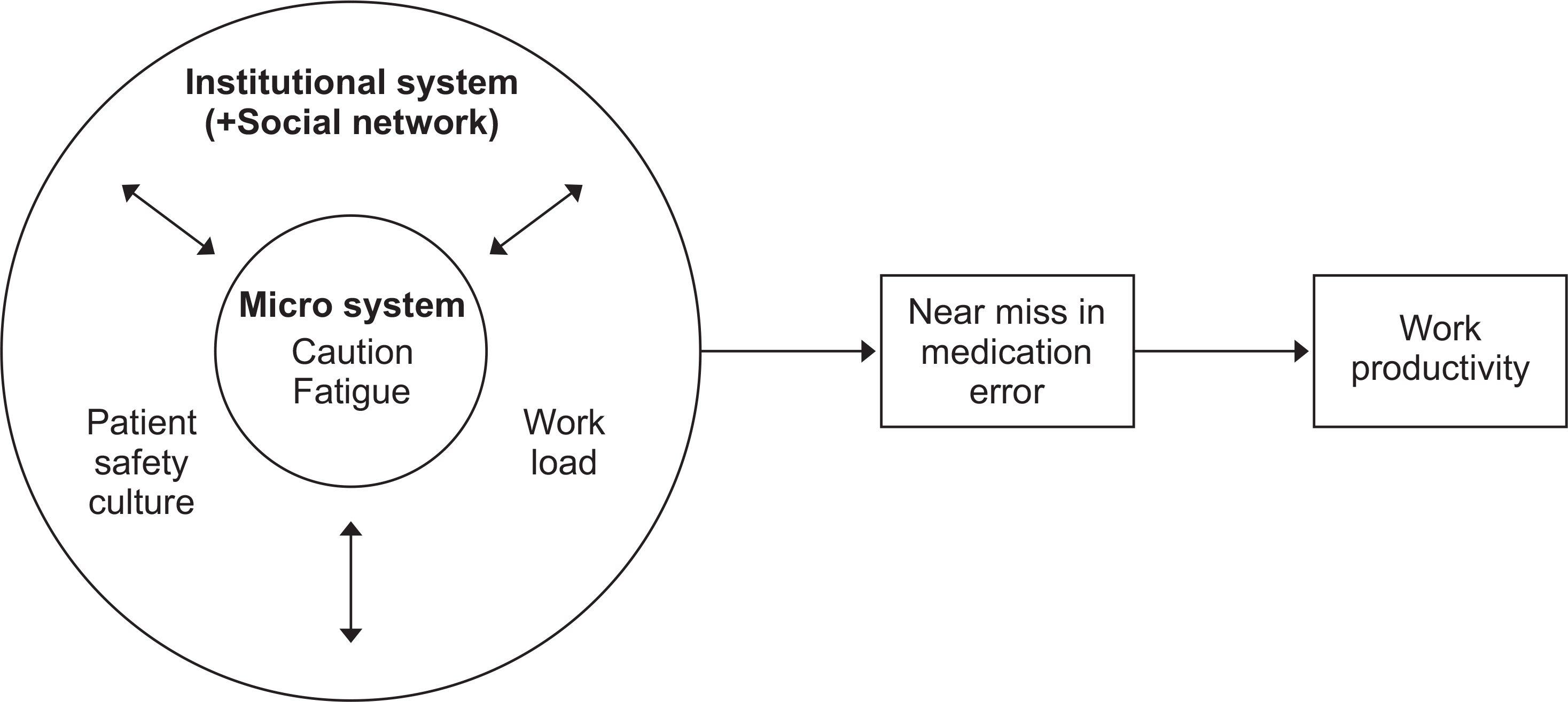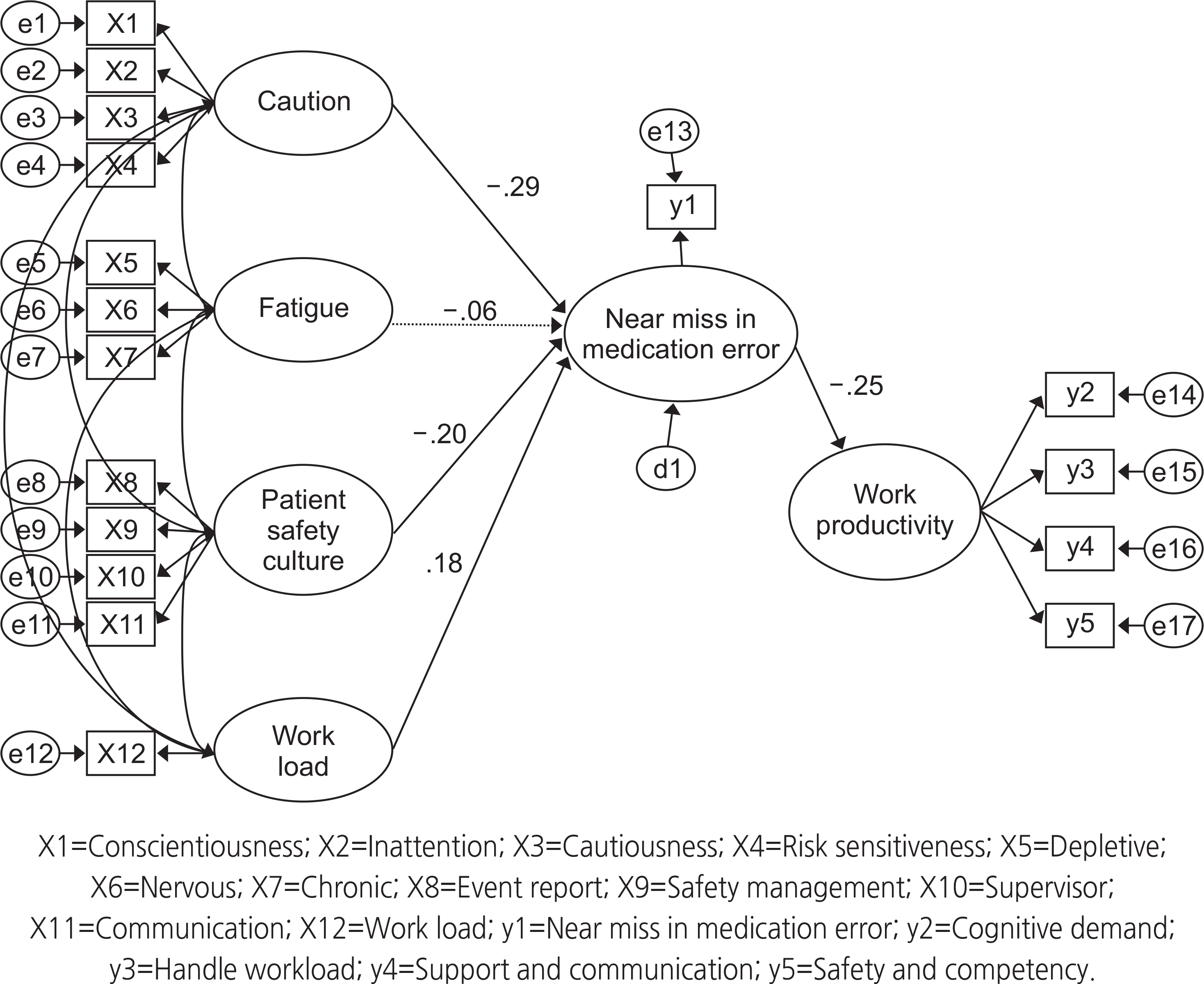J Korean Acad Nurs.
2019 Oct;49(5):631-642. 10.4040/jkan.2019.49.5.631.
Influencing Factors and Consequences of Near Miss Experience in Nurses' Medication Error
- Affiliations
-
- 1Department of Nursing, Changshin University, Changwon, Korea.
- 2College of Nursing, Dong-A University, Busan, Korea. enlee@dau.ac.kr
- KMID: 2461861
- DOI: http://doi.org/10.4040/jkan.2019.49.5.631
Abstract
- PURPOSE
This study aimed to predict the influencing factors and the consequences of near miss in nurses' medication error based upon Salazar & Primomo's ecological system theory.
METHODS
A convenience sample of 198 nurses was recruited for the cross-sectional survey design. Data were collected from July to September 2016. Using the collected data, the developed model was verified by structural equation modeling analysis using SPSS and AMOS program.
RESULTS
For the fitness of the hypothetical model, the results showed that χ² (χ²=258.50, p<.001) was not fit, but standardized χ² (χ²/df=2.35) was a good fit for this model. Additionally, absolute fit index RMR=.06, RMSEA=.08, GFI=.86, AGFI=.81 reached the recommended level, but the Incremental fit index TLI=.82, CFI=.85 was not enough to reach to the recommended level. With the path diagram of the hypothetical model, caution (β=−.29 p<.001), patient safety culture (β=−.20, p=.041), and work load (β=.18, p=.037) had a significant effect on the near miss experiences in nurses' medication error, while fatigue (β=−.06, p=.575) did not affect it. Moreover, the near miss experience had a significant effect on work productivity (β=−.25, p=.001).
CONCLUSION
These results have shown that to decrease the near miss experience by nurses and increase their work productivity in hospital environments would require both personal and organizational effort.
Keyword
MeSH Terms
Figure
Reference
-
References
1. Shin GM. The comparative analysis on the nurse’s medical accident and nurse’s liability. Hanyang Law Review. 2010; 21(4):235–262.2. de Vries EN, Ramrattan MA, Smorenburg SM, Gouma DJ, Boermeester MA. The incidence and nature of in-hospital adverse events: A systematic review. BMJ Quality & Safety. 2008; 17(3):216–223. https://doi.org/10.1136/qshc.2007.023622.
Article3. Hwang JI, Chin HJ, Chang YS. Characteristics associated with the occurrence of adverse events: A retrospective medical record review using the Global Trigger Tool in a fully digitalized tertiary teaching hospital in Korea. Journal of Evaluation in Clinical Practice. 2014; 20(1):27–35. https://doi.org/10.1111/jep.12075.
Article4. Agency for Healthcare Research and Quality (AHRQ). Hospital survey on patient safety culture [Internet]. Rockville (MD): AHRQ;c2015. [cited 2016 Jan 13]. Available from:. https://www.ahrq.gov/sops/surveys/hospital/index.html.5. Speroni KG, Fisher J, Dennis M, Daniel M. What causes near-misses and how are they mitigated? Nursing. 2013; 43(4):19–24. https://doi.org/10.1097/01.NURSE.0000427995.92553.ef.
Article6. Tanaka K, Otsubo T, Tanaka M, Kaku A, Nishinoue N, Takanao T, et al. Similarity in predictors between near miss and adverse event among Japanese nurses working at teaching hospitals. Industrial Health. 2010; 48(6):775–782. https://doi.org/10.2486/indhealth.ms1151.
Article7. Leape LL. Preventing adverse drug events. American Journal of Health-System Pharmacy. 1995; 52(4):379–382. https://doi.org/10.1093/ajhp/52.4.379.
Article8. Moyen E, Camiré E, Stelfox HT. Clinical review: Medication errors in critical care. Critical Care. 2008; 12(2):208. https://doi.org/10.1186/cc6813.
Article9. Parry AM, Barriball KL, While AE. Factors contributing to registered nurse medication administration error: A narrative review. International Journal of Nursing Studies. 2015; 52(1):403–420. https://doi.org/10.1016/j.ijnurstu.2014.07.003.
Article10. Treiber LA, Jones JH. After the medication error: Recent nursing graduates’ reflections on adequacy of education. The Journal of Nursing Education. 2018; 57(5):275–280. https://doi.org/10.3928/01484834-20180420-04.
Article11. Gillespie GL, Gates DM, Succop P. Psychometrics of the healthcare productivity survey. Advanced Emergency Nursing Journal. 2010; 32(3):258–271. https://doi.org/10.1097/TME.0b013e3181e97510.
Article12. Letvak S, Buck R. Factors influencing work productivity and intent to stay in nursing. Nursing Economic$. 2008; 26(3):159–165.13. Kohn LT, Corrigan JM, Donaldson MS. Institute of Medicine U.S. Committee on Quality of Health Care in America. To err is human: Building a safer health system. Washington, D.C.: National Academy Press;1999. p. 1–8.14. Spath PL. Error reduction in health care: A systems approach to improving patient safety. 2nd ed. San Francisco (CA): Jossey-Bass;2011. p. 1–85.15. Jeffs L, Affonso DD, MacMillan K. Near misses: Paradoxical realities in everyday clinical practice. International Journal of Nursing Practice. 2008; 14(6):486–494. https://doi.org/10.1111/j.1440-172x.2008.00724.x.
Article16. Brady AM, Malone AM, Fleming S. A literature review of the individual and systems factors that contribute to medication errors in nursing practice. Journal of Nursing Management. 2009; 17(6):679–697. https://doi.org/10.1111/j.1365-2834.2009.00995.x.
Article17. Salazar MK, Primomo J. Taking the lead in environmental health: Defining a model for practice. AAOHN Journal. 1994; 42(7):317–324.18. Bronfenbrenner U. Toward an experimental ecology of human development. American Psychologist. 1977; 32(7):513–531. https://doi.org/10.1037/0003-066X.32.7.513.
Article19. Oh C, Yoon H. Perception and experience of medication errors in nurses with less than one year job experience. Journal of Korean Academy of Fundamentals of Nursing. 2007; 14(1):6–17.20. Bae BR. Structural equation modeling with Amos 19: Principles and practice. Seoul: Cheongram;2011. p. 198–201.21. Lee SY. A study on medication error among nurses and prevention strategy [master’s thesis]. Daejeon: Eulji University;2008. p. 1–48.22. Park MH. Types and related factors of near miss among hospital workers [master’s thesis]. Daejeon: Konyang University;2012. p. 1–40.23. Choi JY. A study on the effect of psychological characteristics on aviation safety. Korean Journal of Industrial and Organizational Psychology. 2014; 27(1):1–20.
Article24. Jang EH. Development of fatigue scale for nurse [master’s thesis]. Seoul: Chung-Ang University;2013. p. 1–98.25. Kim JE, Kang MA, An KE, Sung YH. A survey of nurses’ perception of patient safety related to hospital culture and reports of medical errors. Journal of Korean Clinical Nursing Research. 2007; 13(3):169–179.26. Kang JM, Park JS. Relationship between perception of patient safety culture and performance for safety care activity in rehabilitation hospital nurse. The Korean Journal of Rehabilitation Nursing. 2016; 19(1):12–19. https://doi.org/10.7587/kjrehn.2016.12.
Article27. Hart SG. Nasa-task load index (NASA-TLX); 20 years later. Proceedings of the Human Factors and Ergonomics Society Annual Meeting. 2006; 50(9):904–908.
Article28. Moon SB. Basic concepts and applications of structural equation modeling with AMOS 17.0. Seoul: Hakji Publisher;2009. p. 100–122.29. Woo JP. Concept and understanding of structural equation model. Seoul: Hannarae Publisher;2012. p. 194–370.30. Kim WP. Structural equation model with AMOS. Seoul: Society and Statistics;2006. p. 195–220.31. Kim EK, Lee SY, Eom MR. DICS behavior pattern and medication errors by nurses. Journal of Korean Academy of Nursing Administration. 2013; 19(1):28–38. https://doi.org/10.11111/jkana.2013.19.1.28.
Article32. Etchells E, Juurlink D, Levinson W. Medication errors: The human factor. Canadian Medical Association Journal. 2008; 178(1):63–64. https://doi.org/10.1503/cmaj.071658.
Article33. Brennan PA, Mitchell DA, Holmes S, Plint S, Parry D. Good people who try their best can have problems: Recognition of human factors and how to minimise error. British Journal of Oral and Maxillofacial Surgery. 2016; 54(1):3–7. https://doi.org/10.1016/j.bjoms.2015.09.023.
Article34. Feng X, Bobay K, Weiss M. Patient safety culture in nursing: A dimensional concept analysis. Journal of Advanced Nursing. 2008; 63(3):310–319. https://doi.org/10.1111/j.1365-2648.2008.04728.x.
Article35. Kim KS, Kwon SH, Kim JA, Cho SH. Nurses’ perceptions of medication errors and their contributing factors in South Korea. Journal of Nursing Management. 2011; 19(3):346–353. https://doi.org/10.1111/j.1365-2834.2011.01249.x.
Article36. Ricci M, Panos AL, Lincoln J, Salerno T, Warshauer L. Is aviation a good model to study human errors in health care? The American Journal of Surgery. 2012; 203(6):798–801. https://doi.org/10.1016/j.amjsurg.2011.06.010.
Article37. Kessels-Habraken M, Van der Schaaf T, De Jonge J, Rutte C. Defining near misses: Towards a sharpened definition based on empirical data about error handling processes. Social Science & Medicine. 2010; 70(9):1301–1308. https://doi.org/10.1016/j.socscimed.2010.01.006.
Article38. Billstein-Leber M, Carrillo JD, Cassano AT, Moline K, Robertson JJ. ASHP guidelines on preventing medication errors in hospitals. American Journal of Health-System Pharmacy. 2018; 75(19):1493–1517. https://doi.org/10.2146/ajhp170811.
Article39. Kear T, Ulrich B. Patient safety and patient safety culture in nephrology nurse practice settings: Issues, solutions, and best practices. Nephrology Nursing Journal. 2015; 42(2):113–122. quiz 123.40. Paparella S. Caring for the caregiver: Moving beyond the finger pointing after an adverse event. Journal of Emergency Nursing. 2011; 37(3):263–265. https://doi.org/10.1016/j.jen.2011.01.001.
Article41. Gates DM, Gillespie GL, Succop P. Violence against nurses and its impact on stress and productivity. Nursing economic$. 2011; 29(2):59–66. quiz67.42. Lee HS, Lim JH. SPSS 22 manual. Seoul: Jiphyunjae;2015. p. 21–56.
- Full Text Links
- Actions
-
Cited
- CITED
-
- Close
- Share
- Similar articles
-
- A Study on Factors Affecting Near Misses by Nurses in Small-Medium Sized Hospitals
- A Phenomenological Study on Nurses' Experience of Near Miss in Medication Administration
- Descriptive Analysis of Medication Errors and Contributing Factors in Clinical Trials at a Single Institution
- Perception and Experience of Medication Errors in Nurses with Less than One Year Job Experience
- Factors Influencing Clinical Nurses’ Intention to Report Medication Administration Errors



